20+ Tips and Tools to Make Your Interactive Exercises Accessible to all Learners
 Dimitri Bongers —
Dimitri Bongers —
Cities are taking steps towards inclusivity, recognizing the importance of creating public spaces that cater to everyone. With initiatives like audio signals at traffic lights, Braille texts at information boards, and accessible public transport, they want to provide an environment where everyone can navigate and engage seamlessly.
In the same way, the digital realm, including websites and online educational tools, should embrace measures that prioritize accessibility for all users. In this blog post, we explore the steps teachers can take to make their interactive exercises using BookWidgets as inclusive and accessible as possible. The good news is that there are many options, both within BookWidgets and through other tools that work well in conjunction with BookWidgets. With easy, seamless deployment, you can ensure your digital exercises are accessible to all learners.
It’s good to know BookWidgets has a Voluntary Product Accessibility Template, or VPAT document. This document describes how well the product conforms to the accessibility standards of Section 508 of the Rehabilitation Act. Click here to read BookWidgets’ VPAT.
You can read this blog post from top to bottom or jump straight to the section that interests you most:
- What is BookWidgets?
- What can teachers do to improve the accessibility of their interactive BookWidgets exercises?
- Which tools can students needing accommodations use in combination with Bookwidgets?
Before writing this blog post, I had a video Interview with Vincent Leone, a Belgian Instructor and Apple Professional Learning Specialist (APLS). Vincent is visually impaired, but most of all, he is very passionate about new technologies, which can make the barriers of his disability disappear. Several examples in this blog post come from Vincent. French-speaking schools interested in a professional development session by Vincent can contact him through his website.

Vincent doing a training with his dog Pim’s on the background

What is BookWidgets?
BookWidgets is a content creation and evaluation tool for teachers. With an extensive library of 40+ templates, BookWidgets allows teachers to create quizzes, worksheets, crossword puzzles, timelines, flashcards, and more. These interactive exercises can be shared within the most common LMSs (Google Classroom, Microsoft Teams, Moodle, Canvas, …). Teachers can follow their students’ activity live while they are doing the exercises and review their answers in the grading dashboard before sending feedback.
What makes BookWidgets stand out from other platforms and tools is the extensive customization of content creation using our widgets. A variety of settings provides teachers the opportunity to adapt exercised to their teaching styles and the needs of their students. This customization also offers numerous possibilities in regards to accessibility, differentiate instruction and Universal Design for Learning (UDL) - all which will be discussed below.

What can teachers do to improve the accessibility of their interactive BookWidgets exercises?
1. Give clear instructions
The first tip is not necessarily a technological solution, as it also applies to paper handouts or tasks you announce orally: make sure your instructions are always clear so students know what’s expected from them.
In BookWidgets, you can formulate clear instructions using the Text question in a Quiz or Worksheet. And, of course, you can provide further instructions in the assignment of each question.
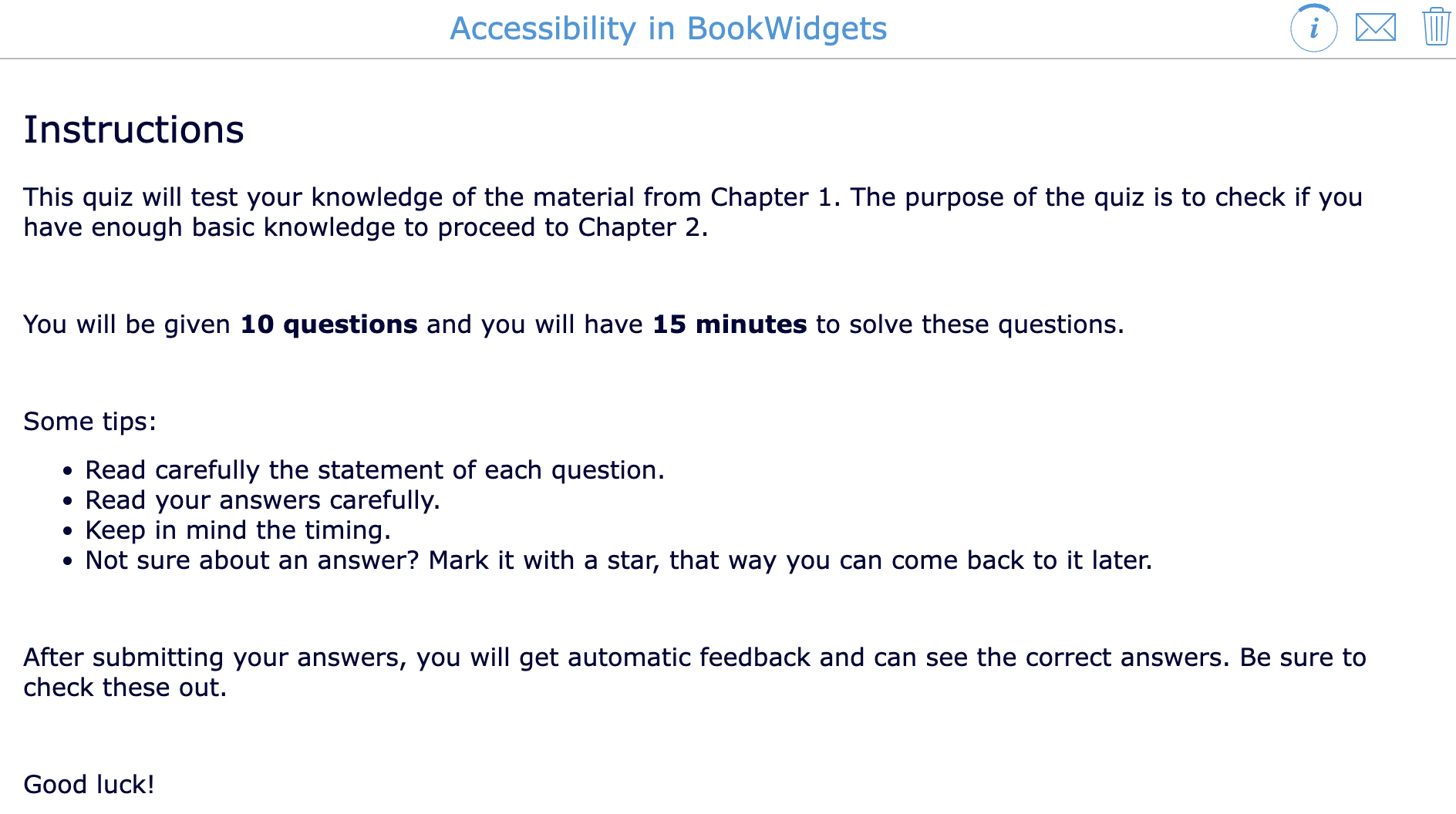
There is an option to add Instructions for other widget types like the Crossword Puzzle, Timeline, Memory, and more. The instructions you enter here will appear in a pop-up when the widget is launched, and students can access it again by clicking on the icon in the upper right corner.
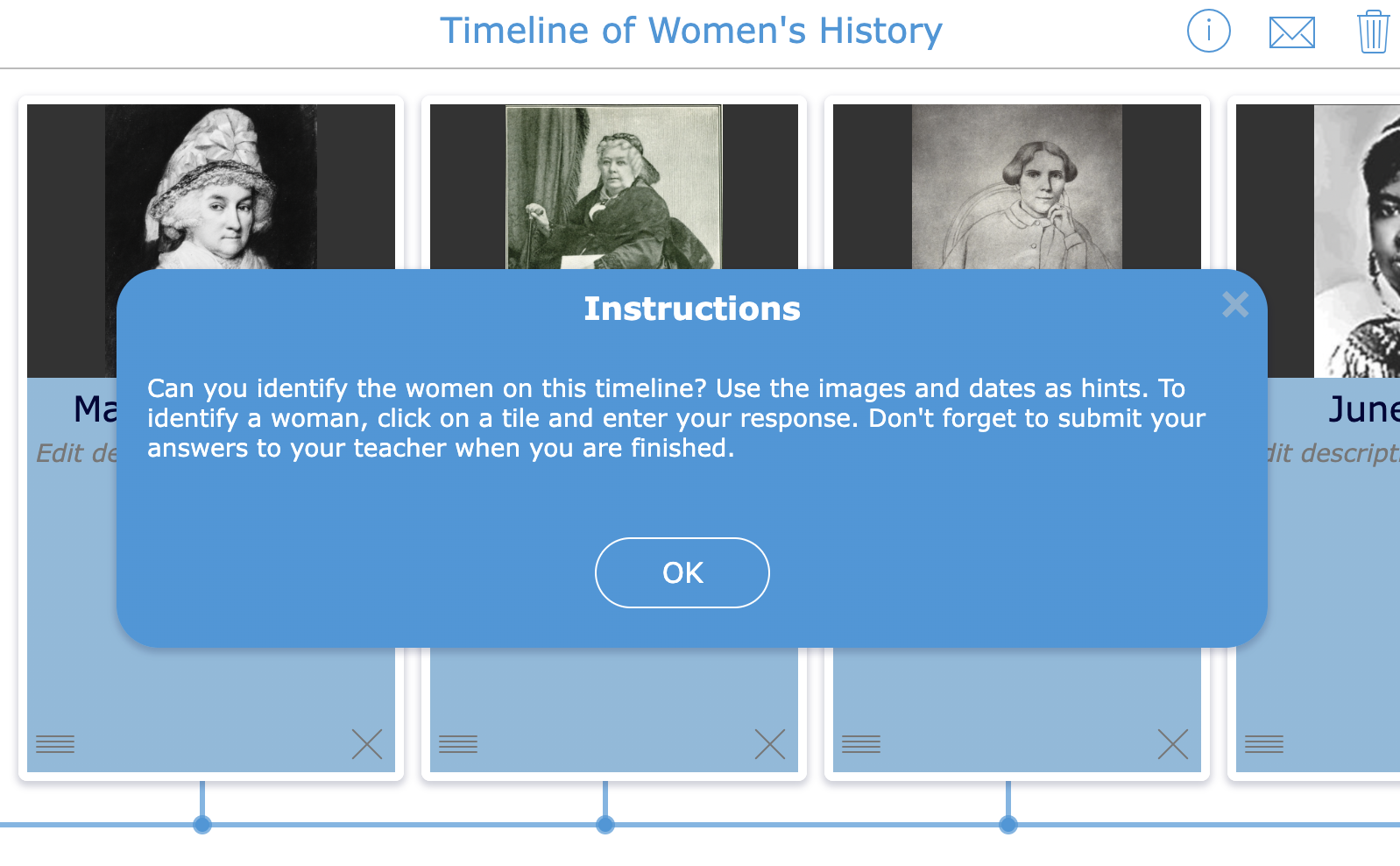
2. Add hints
Keep in mind that not all students have an equally strong basic knowledge and this often affects their chances of success. For example, students who have limited command of language may score poorly on word problems in math despite being strong in mathematical exercises.
In BookWidgets, you could use the “hint” option to add additional information to the task or vocabulary explanations. You can also add images and videos in the “hint”. The following instructions will be difficult for students who don’t understand the word “discount”. Providing the hint is helpful.
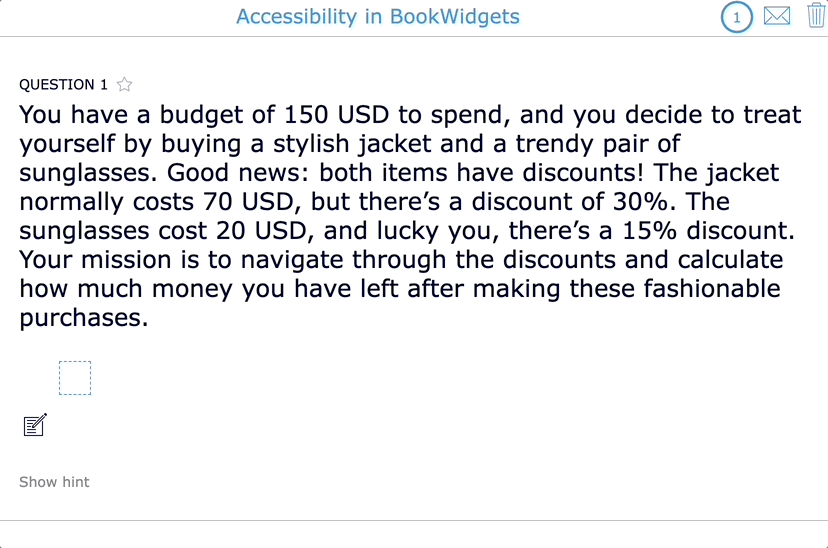
3. Change the font with the rich text editor
In addition to formulating clear instructions, you can make it easier for students to process the content visually. In BookWidgets, you can use the rich text editor to:
- adjust font sizes;
- underline text or make it bold;
- change the color;
- insert bullets;
- and more.
Below you will see the same instructions twice. This example clearly shows the added value of using these text features..
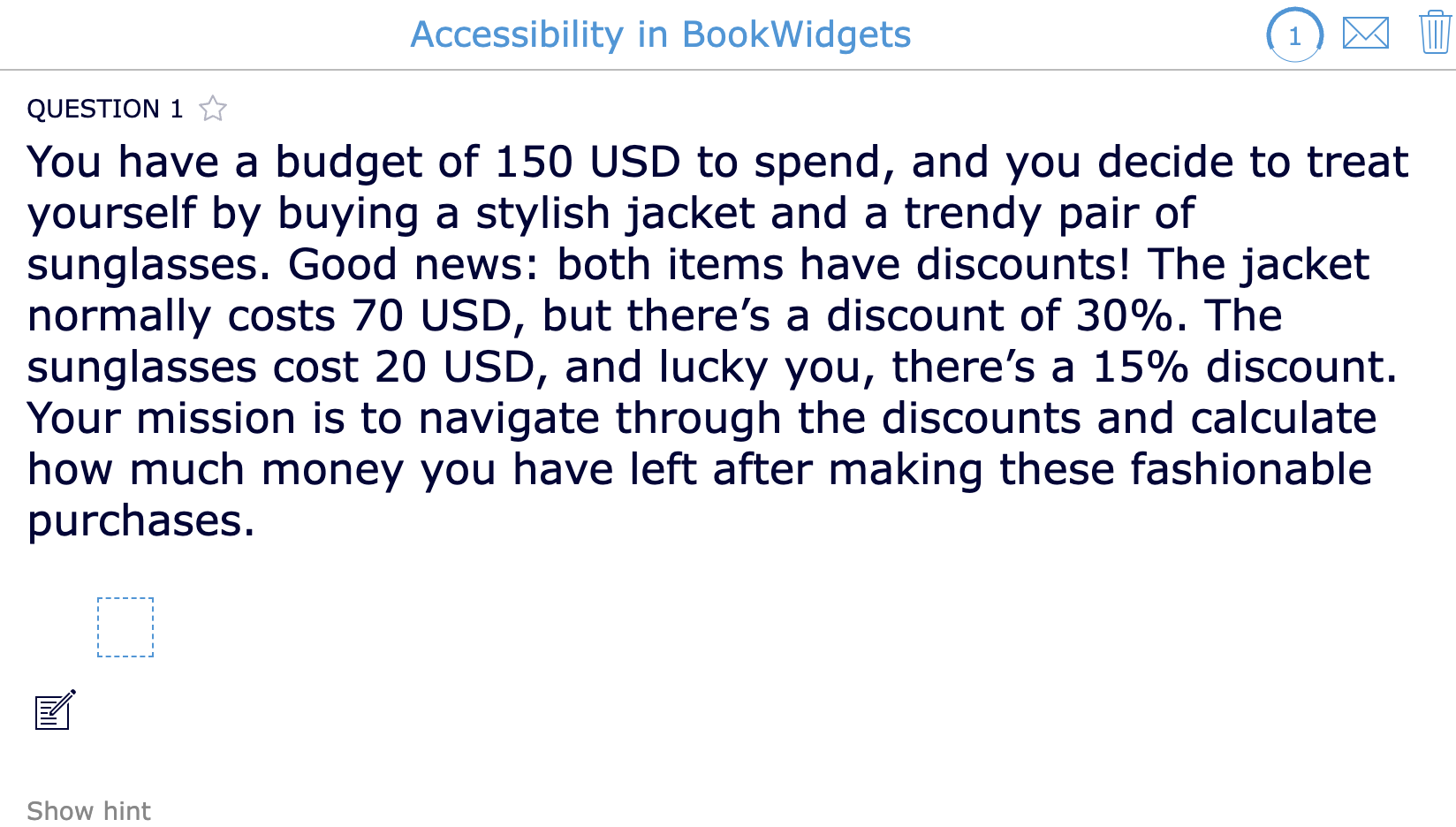
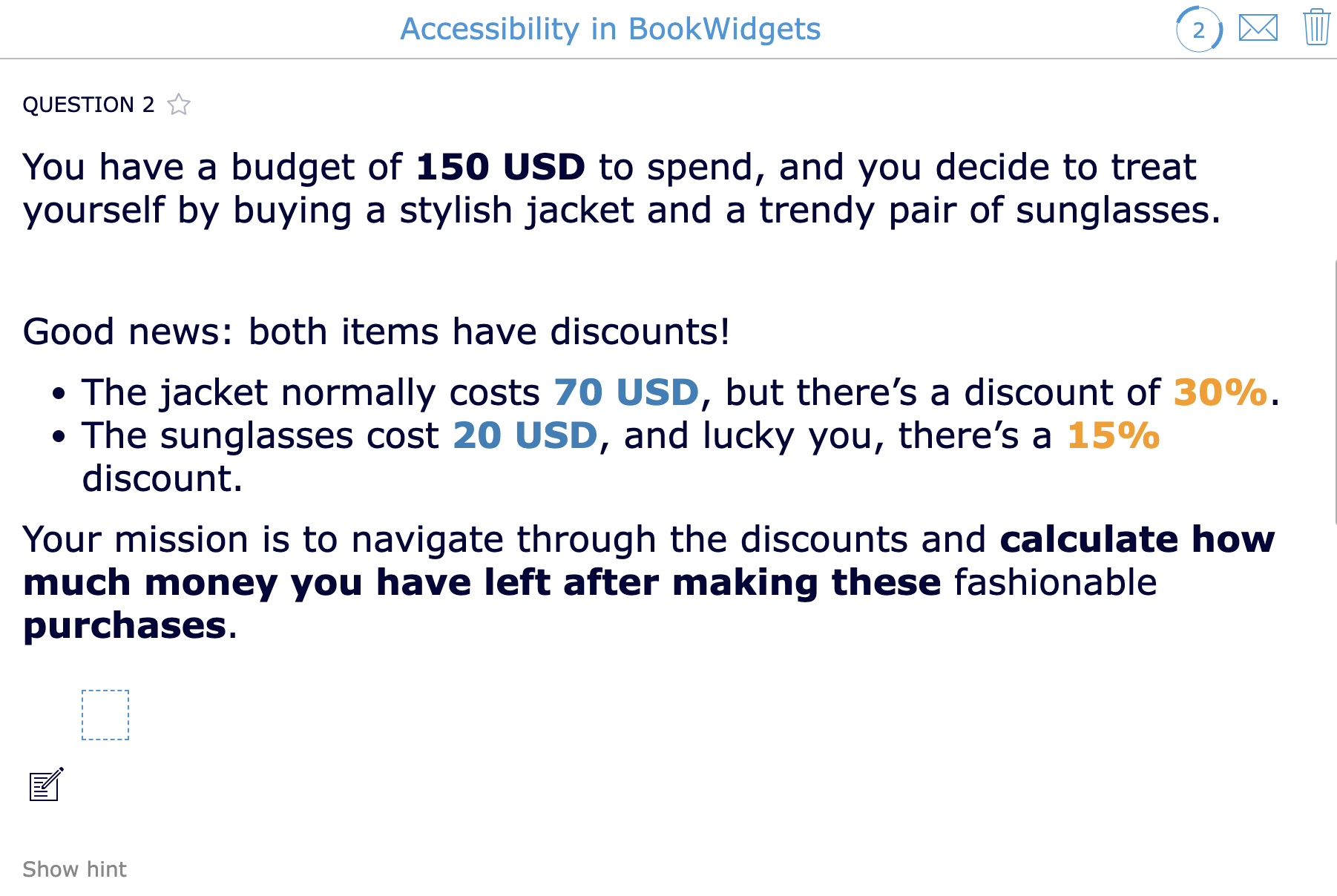
💡 Pro tip: In the Student view, the “Design” button also allows you to customize the entire layout of each question if you have a plan that includes this option.
4. Add audio clips
In BookWidgets, every question type in the Quiz and Worksheet widget has an audio option, which allows you, the teacher, to add audio clips for students to listen to. In all other places where you type text, you can add audio, e.g., in the instructions, hints, rationale, etc.
There are also plenty of opportunities to work with audio instead of text in various widgets and question types, such as the Pair Matching widget, the Audio-Picture Match question, and more.
💡 Best practice: you don’t need a separate tool to record audio; an audio recording feature is built into BookWidgets.
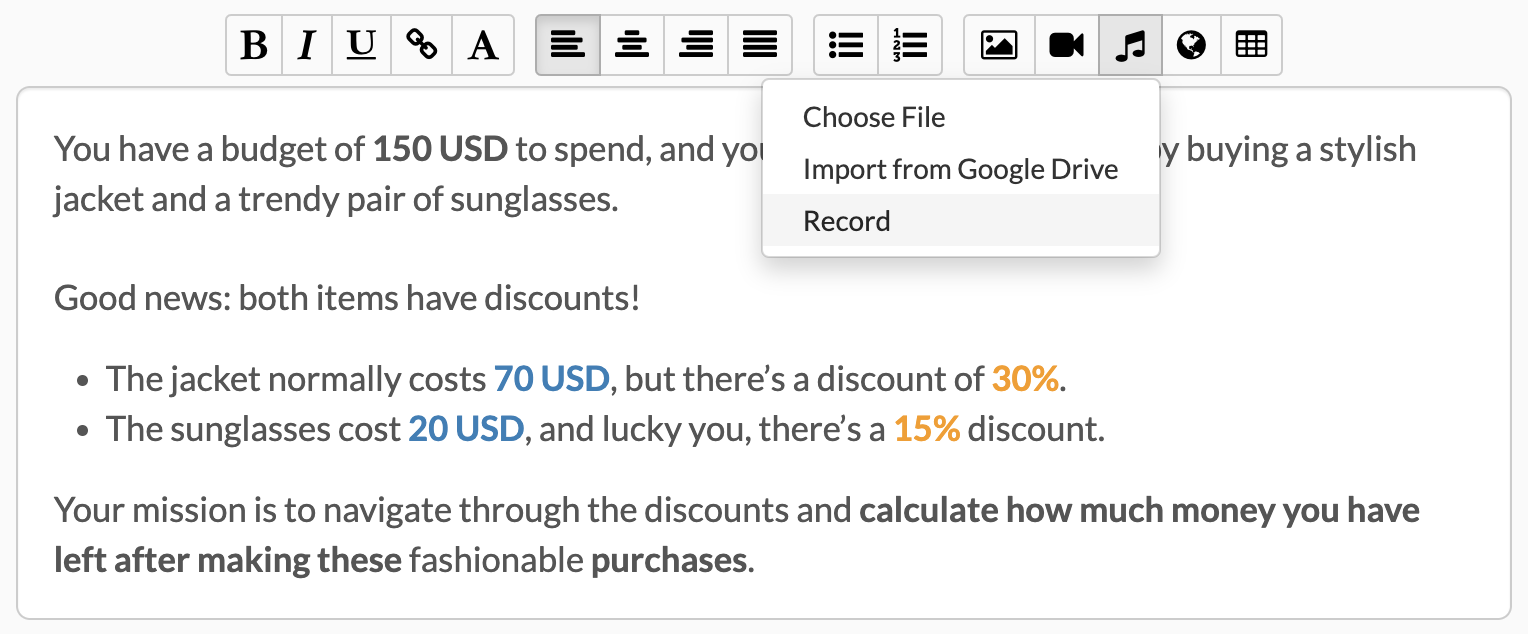
5. Use the Audio recording question type
Keep in mind that text typing is not equally accessible to all learners. In the Quiz, Worksheet, Split worksheet, and Video quiz, you can also provide Audio recording questions where learners can record their answers instead of typing.
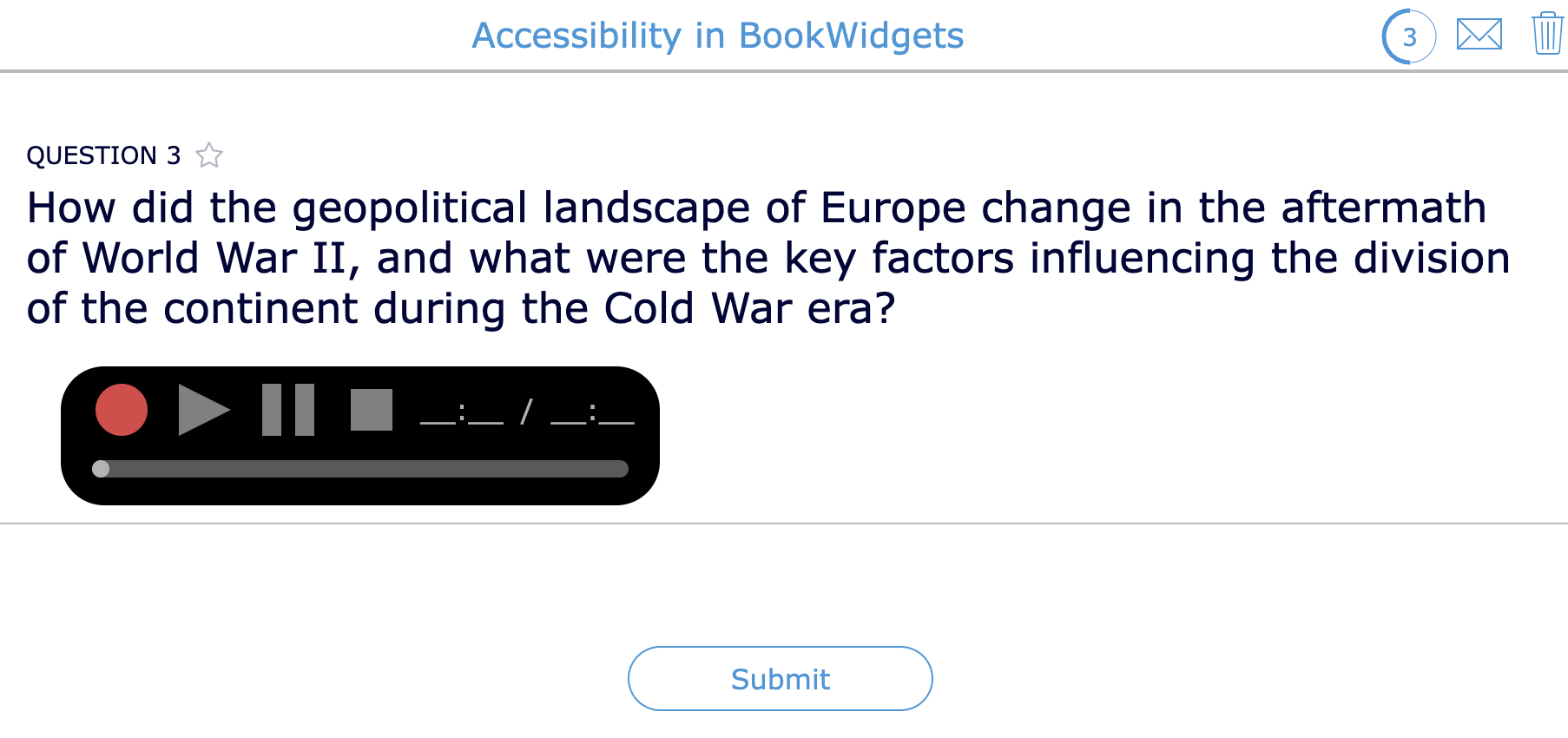
6. Allow text selection and text-to-speech in Quizes and Worksheets
By default, students are not able to select text in BookWidgets. In the context of accessibility, it is often advisable to make this possible because the text must be selectable when students use certain text-to-speech software or screen readers (more about this later).
💡 Best practice: To allow text selection, go to the “General” tab in the widget editor. In the “Text selection and text-to-speech” section, check the option “Allow text selection”. When students use their own text-to-speech software, you’re all set. If not, use the next options to enable the browser built-in text-to-speech. Students will then be able to select all the text within the widget and listen to it.
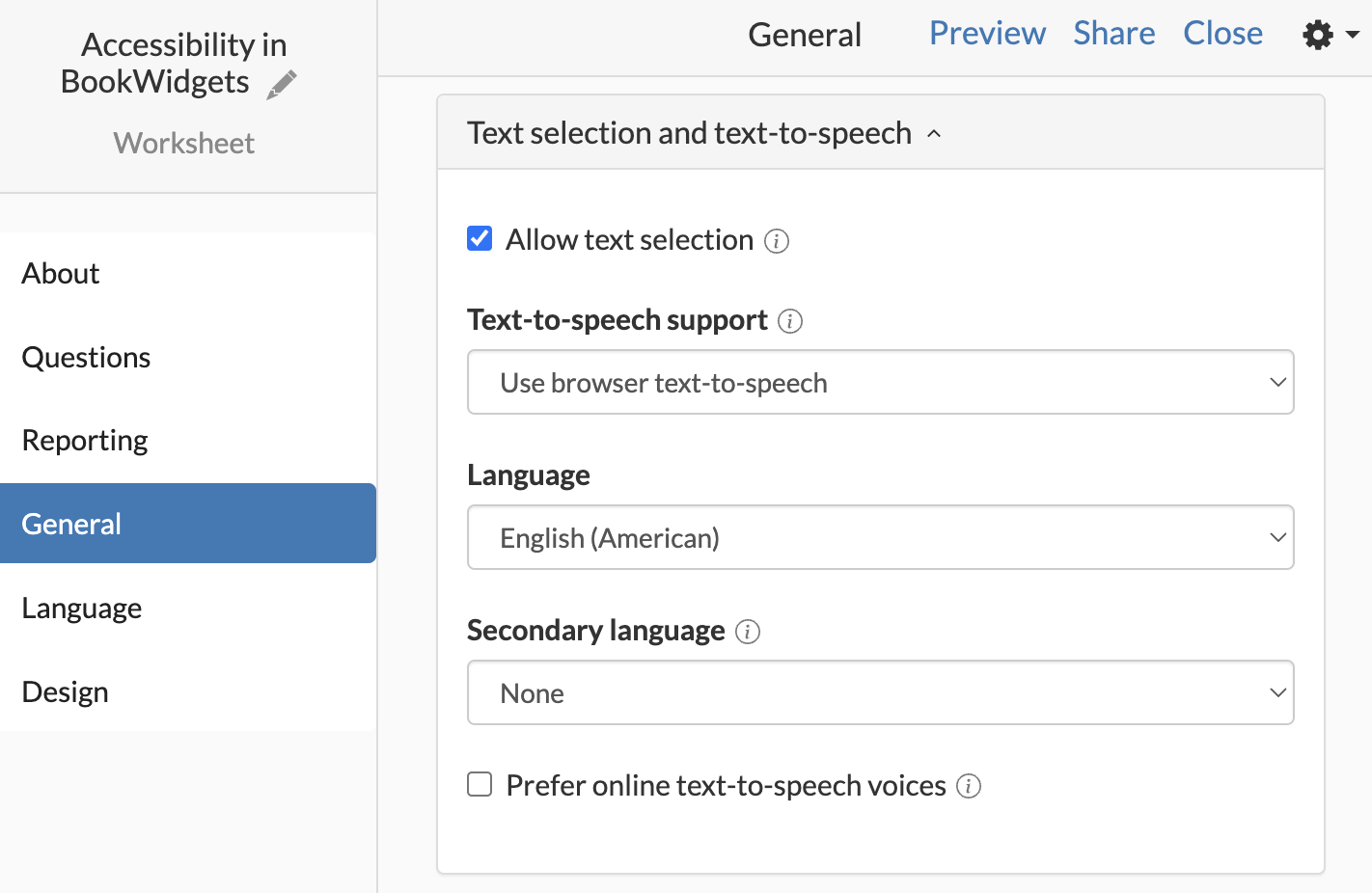
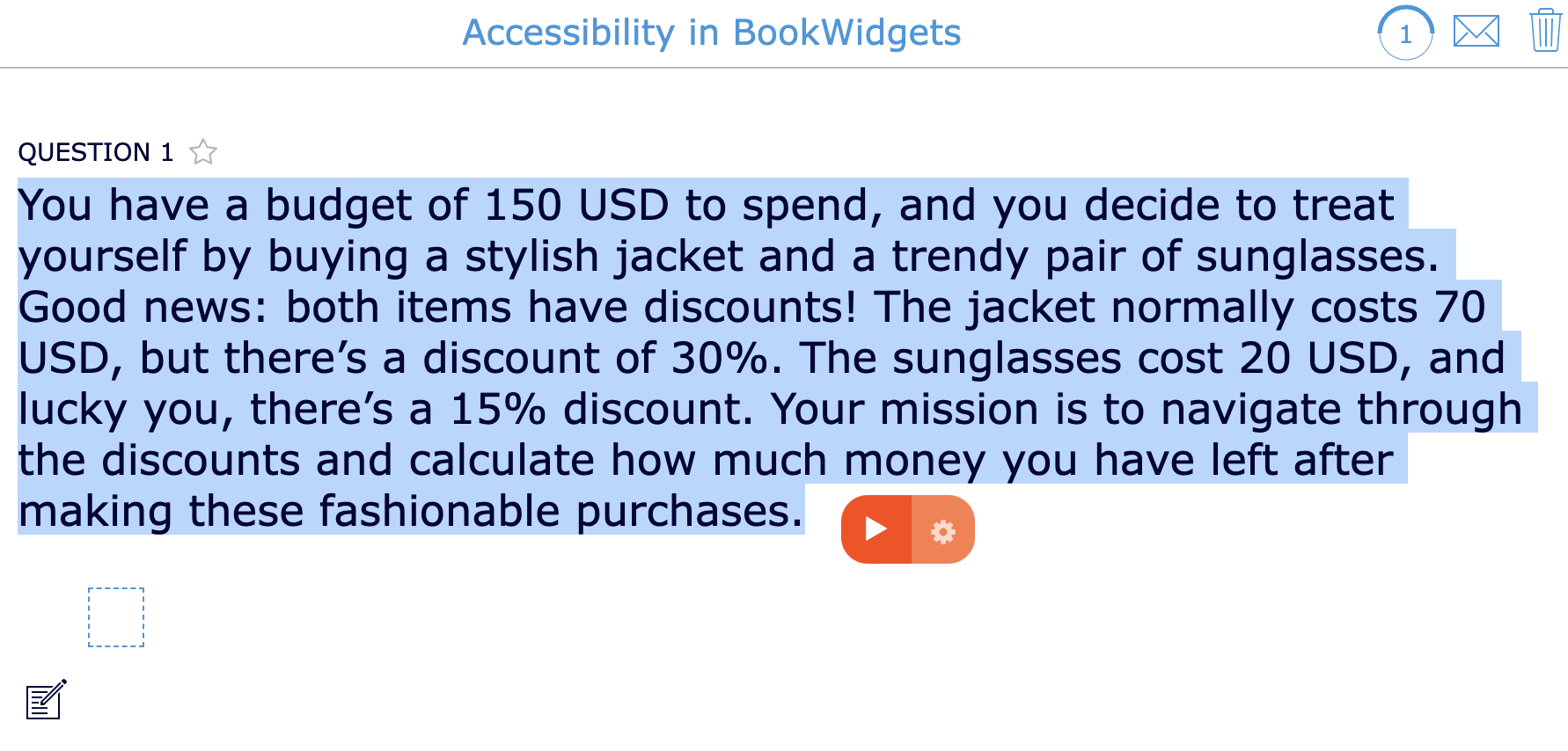
7. Enable the Speech option in the Pair Matching, Memory and Flashcard widgets
BookWidgets offers more than 40 different types of interactive exercises, and we do our utmost to make them all as accessible as possible. For example, in the Pair Matching, Memory and Flashcard widgets it is also possible to activate automatic text-to-speech, so that students can also listen to the words when learning new vocabulary. This is a perfect example of how, as a teacher, you can improve the accessibility of an interactive exercise for all learners in one click.
💡 Best practice: To enable the Speech option in these widgets, first add the cards with your text, then go to “Speech options” on the “General” tab.
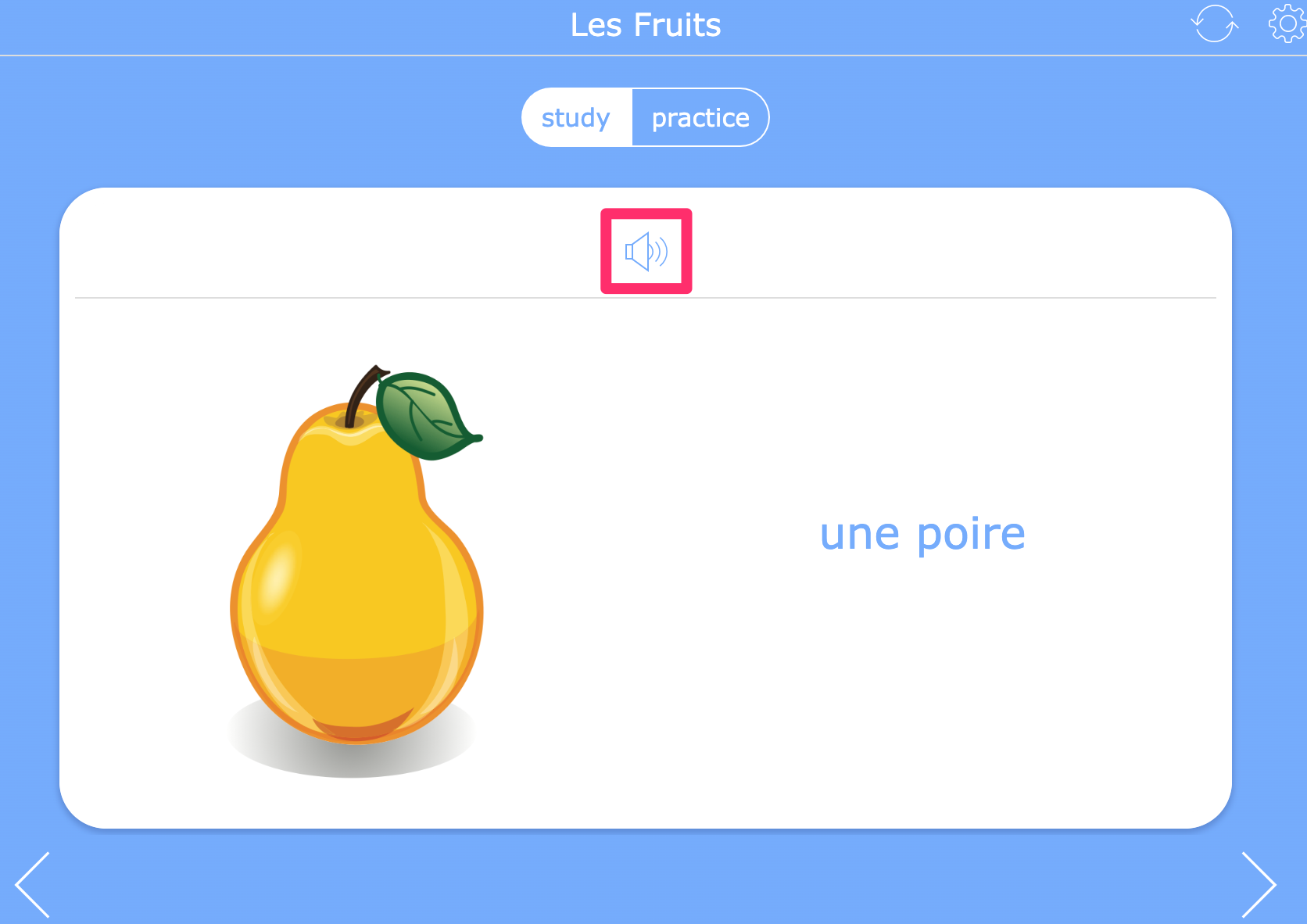
8. Use the power of images
A picture paints a thousand words. Another way to make your interactive exercises in BookWidgets as accessible as possible is to provide supporting images. In BookWidgets, you can add images in almost all places. Thanks to the built-in Pixabay photo library, this goes very smoothly.
On the other hand, you should consider that students with a visual impairment may experience difficulties with image-based exercises (e.g., matching words and images). It’s good to know that most images in BookWidgets are zoomable by clicking on them.
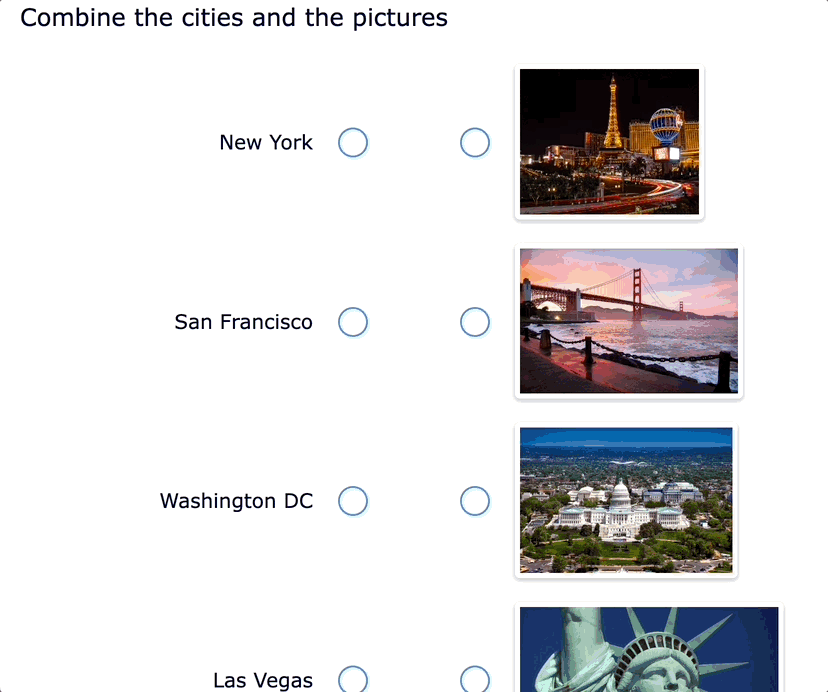
Additionally, you can add alt text to most images in BookWidgets. Various screen readers can read these alt texts so that students with visual impairments can understand the image’s content.
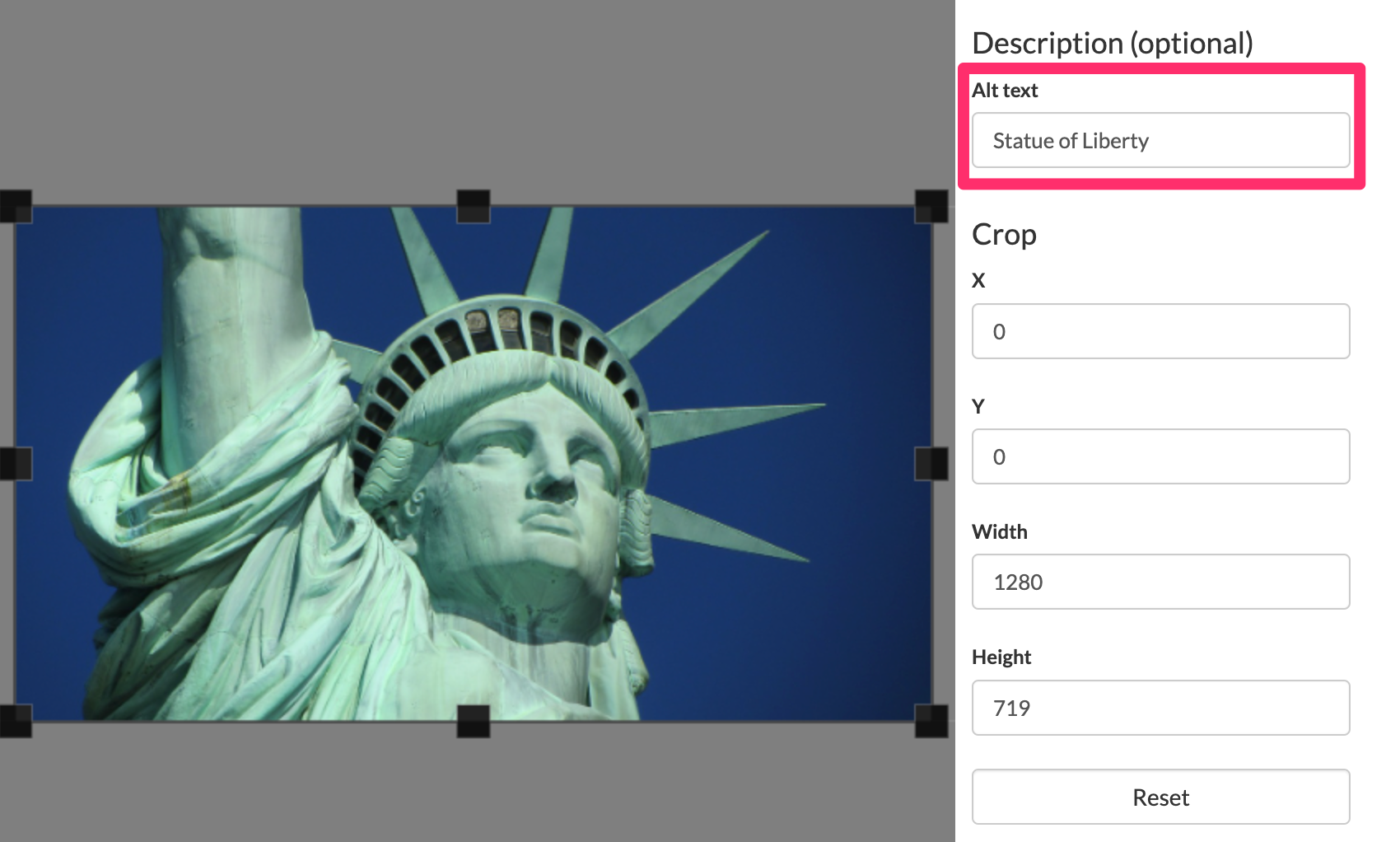
9. Use the power of emojis 🙌
In the context of an online assignment or interactive exercise, utilizing emojis in instructions can enhance understanding for individuals with reading disorders including dyslexia. Emojis are more easily and intuitively grasped than lengthy texts, aiding comprehension. However, teachers must employ them thoughtfully. Overusing emojis may lead to confusion rather than assistance, as learners might focus solely on the emojis and not the surrounding text.
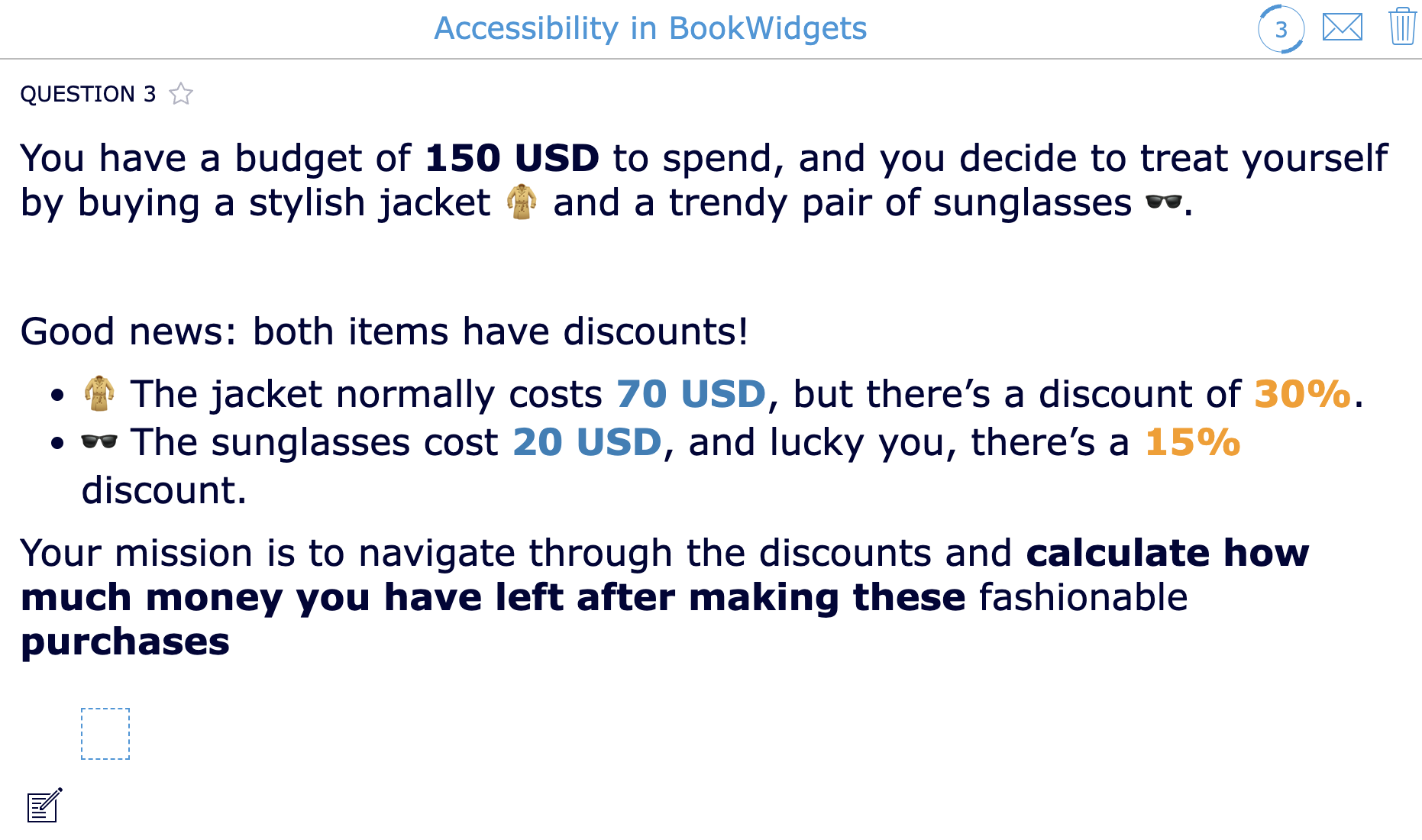
To add emojis in a text simply right click and choose “Emoji & symbols”. Alternatively, use a shortcut:
- on a Mac device: “fn” or “Ctrl + Cmd + space”
- on a Windows device: “Windows logo key + . (period)”
💡 Pro tip: On the “Language” tab in the widget editor, you can change the language of all buttons and dialog boxes in BookWidgets and add emojis here. For example, you can place an envelope icon next to the “Submit” button.
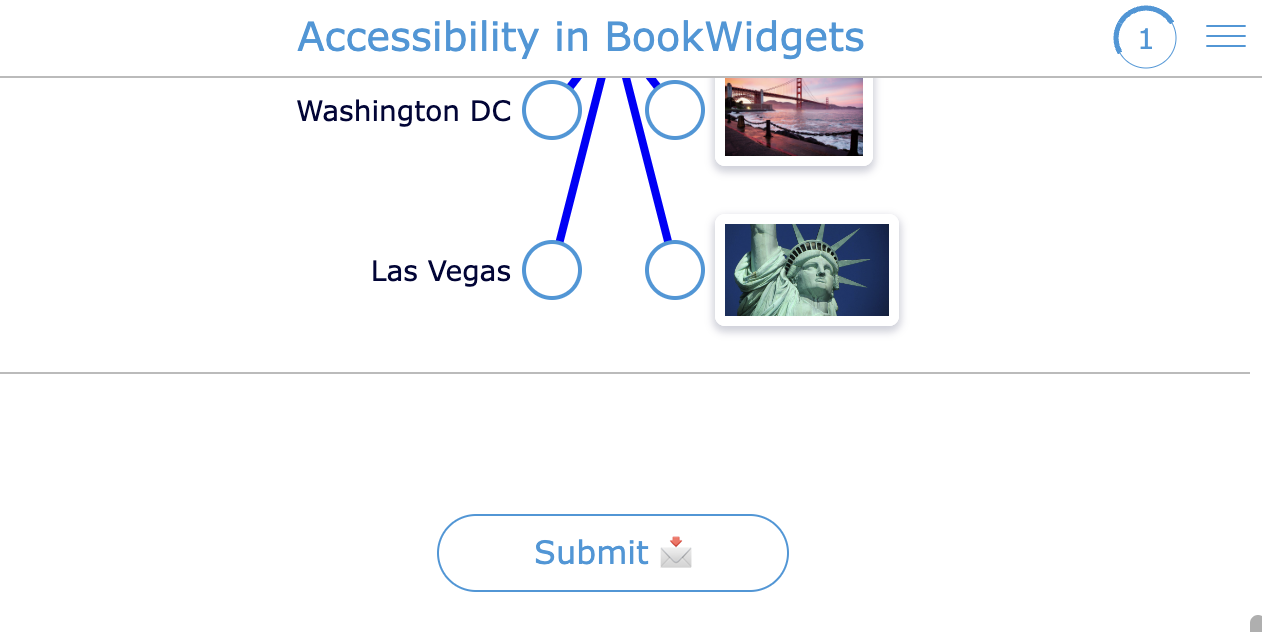
For more lesson ideas with emojis, check this blog post.
10. Enable the Scratchpad
Enabling a Scratchpad in BookWidgets Quizzes and Worksheets supports students with additional needs or learning disabilities by providing a designated space for note-taking. This feature allows students to work independently, aiding comprehension and reducing cognitive load. The Scratchpad can help students jot down their thoughts or make sketches. This makes it easier for students to work out an exercise step by step before completing the final answer. The teacher can also look at the Scratschpad when reviewing the students’ answers, which will help to understand the students’ thought processes.
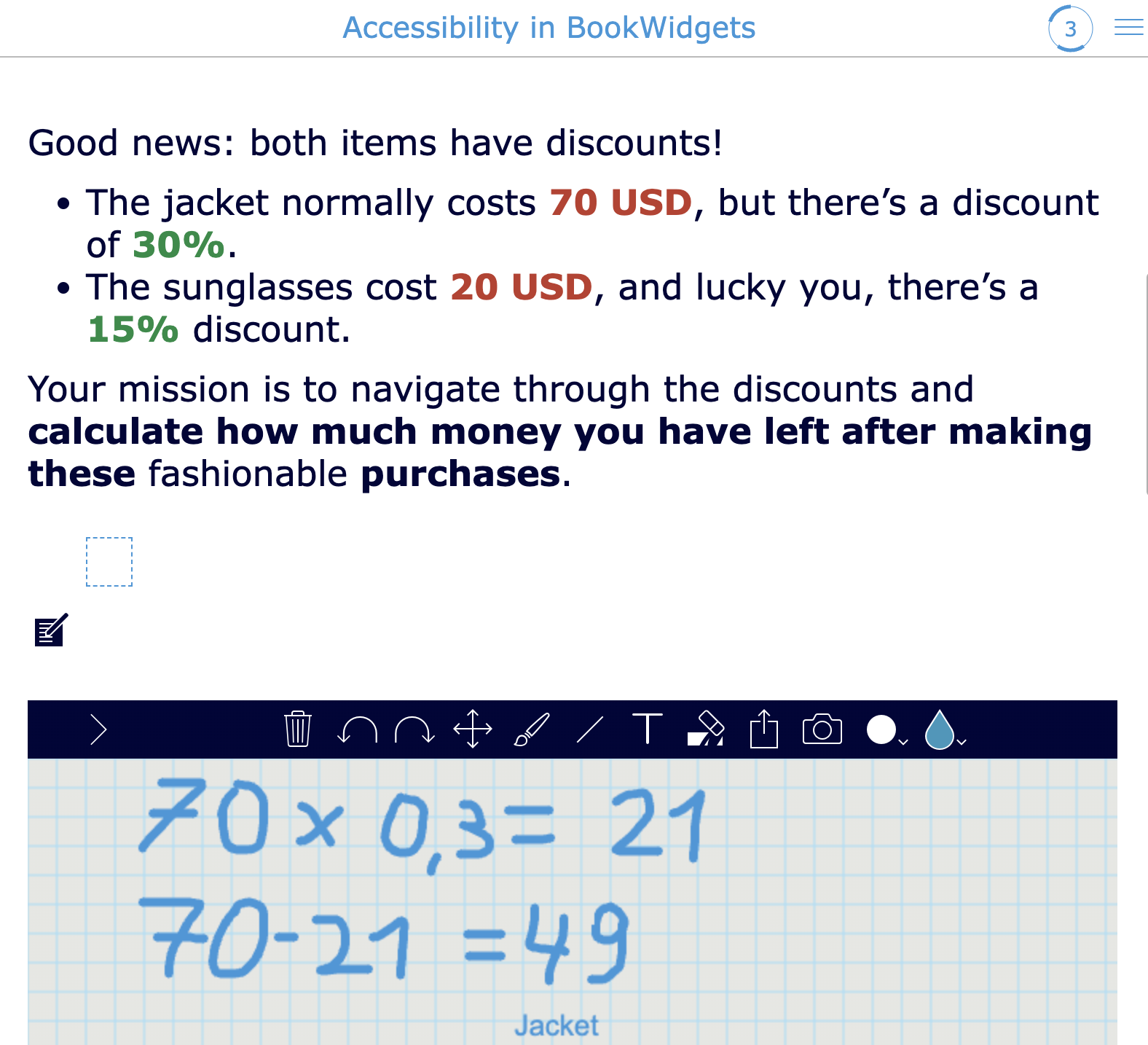
The Scratchpad is one of the options on the “General” tab in the widget editor.
11. Enable the Spell check
Enabling the Spell check option in BookWidgets exercises is essential for students with learning disabilities, ensuring accurate written expression. This feature assists in identifying and correcting spelling errors, promoting clarity in communication. By reducing the risk of spelling mistakes, the Spell check option supports students in conveying their thoughts effectively. It fosters confidence in written tasks and enhances overall comprehension for individuals with diverse learning needs.
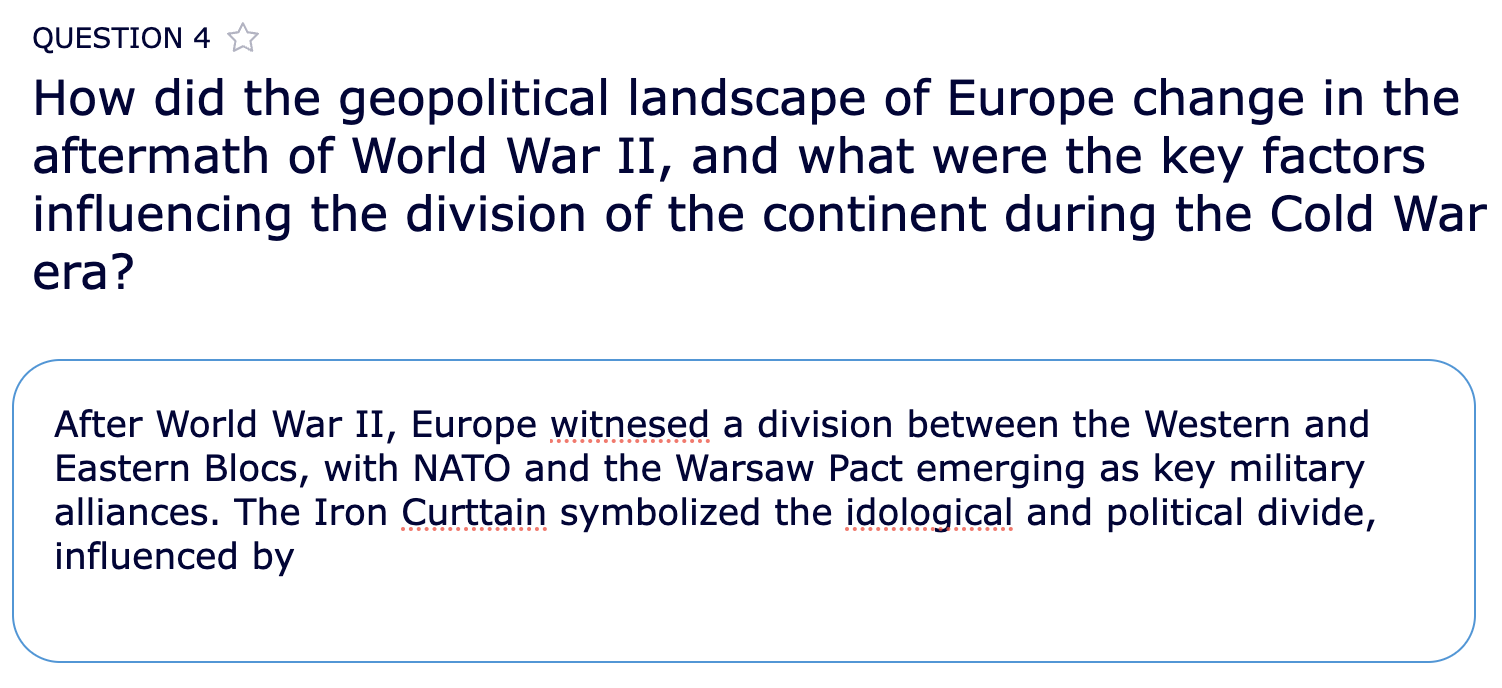
The Spell check is one of the options on the “General” tab in the widget editor. It is browser-based, so students need to have the spell checker enabled in their browser. When writing in a different language, adding this language in the browser setting might be necessary.
12. Use the Equations question type for mathematical characters
Typing mathematical and scientific characters with a keyboard is not simple. If you would expect this from students, you are more likely to test their computer skills than their mathematical knowledge. Fortunately, in BookWidgets, there is a the Equations question type that allows students to simply click on the mathematical characters they need to solve an exercise.
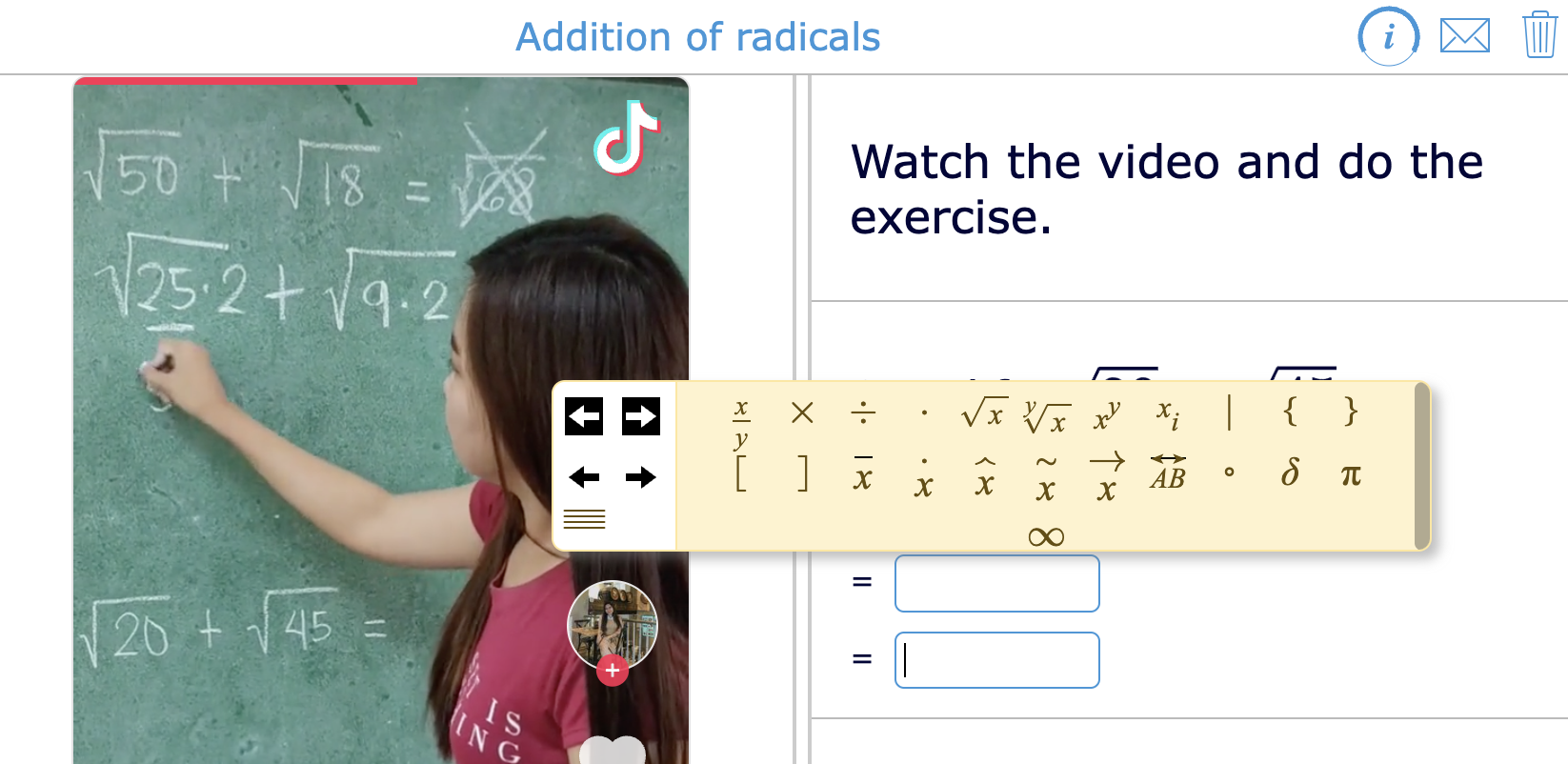
13. Visual keyboard
Typing accents and special characters is not as evident to all students.Thus, when your expected answers contain words with accents or special characters (for example, in the case of world languages such as Spanish or French), some students would automatically be disadvantaged. They would have to choose between losing time to type the answers correctly, or losing points when, e.g., not typing accents in their answers. This is very easy to solve by activating the On-screen keyboard. You can find this option on the “General” tab.
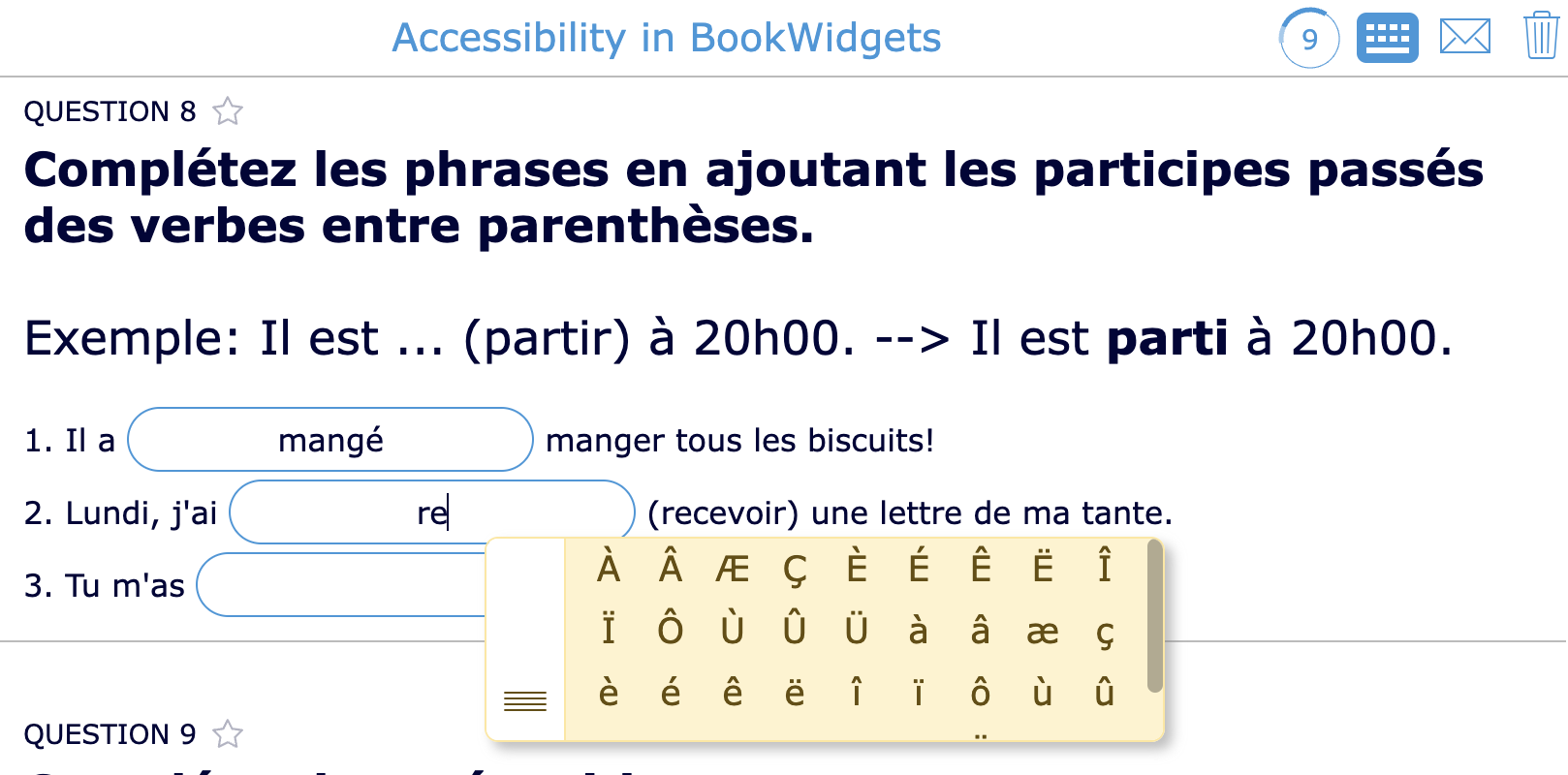
14. Follow students live
While students are working on a widget, you can track their progress in the Live dashboard. Each student works at their own pace, but as a teacher, you can see who is slower or makes more mistakes. This allows you to perfectly assess which students need extra help, and which others might just need extra challenges. Thus, it is a perfect tool to use differentiation effectively.
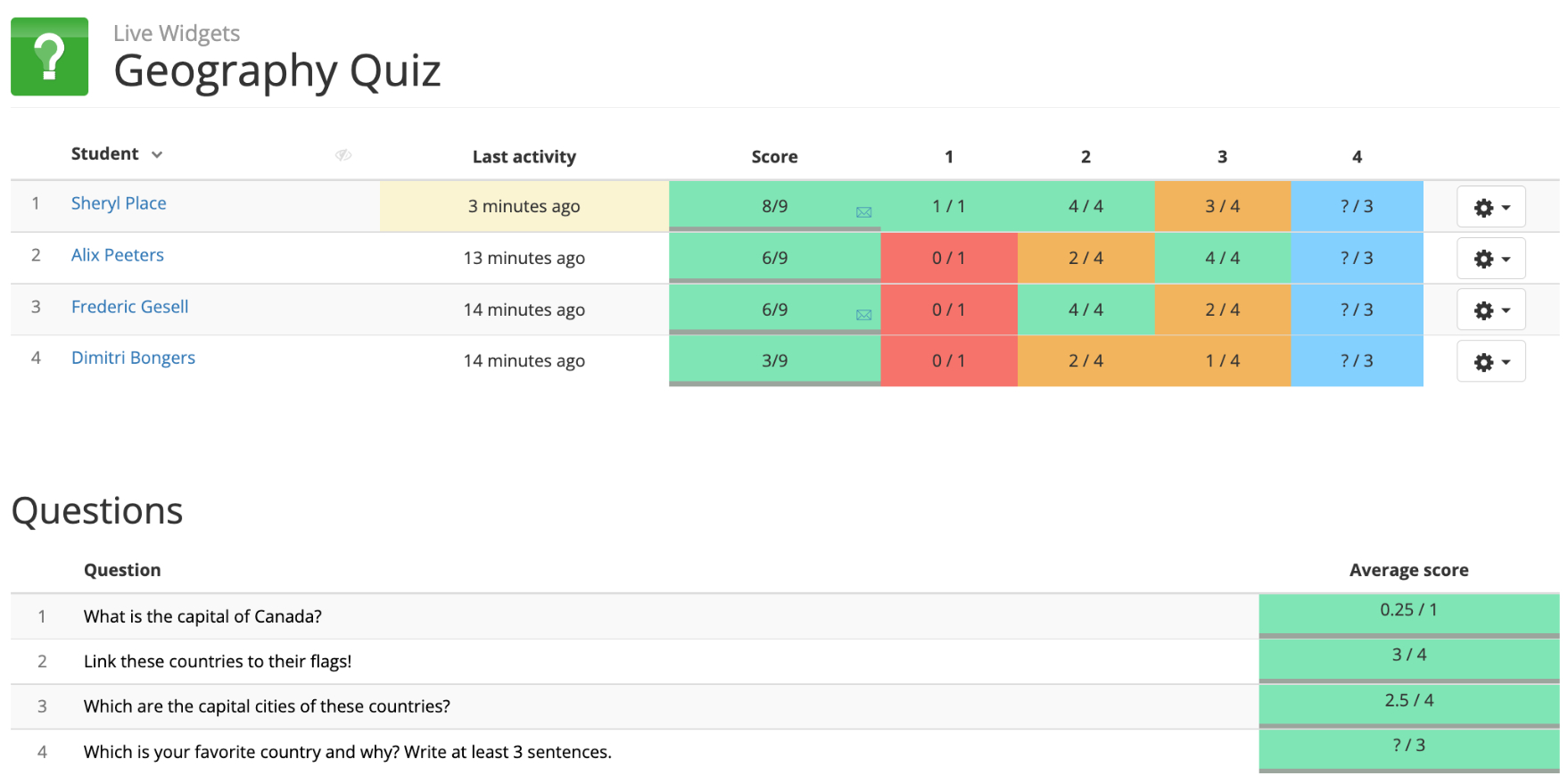
Read more about the Live feature here.

Which tools can students needing accommodations use in combination with Bookwidgets?
15. Adjust the color settings for colorblind students and teachers
8% of men and 0.5% of women have color vision deficiency (CVD). As a teacher, sooner or later, you will have students with color vision deficiency in your class. Tasks like annotating specific elements on an image in different colors (= the Whiteboard widget/question), may be complicated for them. Teachers with color vision deficiency may struggle with the red, green, orange, and blue indications for results in the Live and Grading & Reporting Dashboards.
Fortunately, you can adjust the color in the settings of your operating system. The advantage is that this helps people with color vision deficiency people on all websites and programs. Find more information on how to change display colors for different devices on the links below:
- Change display colors on Mac
- Change display colors on iOS
- Change display colors on Windows
- Change display colors on Android
16. Text-to-speech software and screen readers
Text-to-Speech (TTS) is a technology that converts written text into spoken words. It is often used to provide an audio representation of text, making it accessible to students who may have difficulty reading.
Screen readers, on the other hand, are software applications that are designed to assist individuals with visual impairments or those with low vision in accessing digital content. These tools read aloud the content displayed on the screen, including text, buttons, and other elements. Screen readers not only utilize TTS to convert text into speech but also provide additional features like navigation shortcuts, context descriptions, and support for interacting with the user interface.
Here’s a non-exhaustive list of screen TTS tools and screen readers that students can use within BookWidgets:
- The text-to-speech option within BookWidgets (can be found in the widget editor on the “General” tab);
- Most browsers have a built-in text-to-speech feature. (can be found by selecting the text you want to read and a right click)
- VoiceOver (iOS and Mac)
- ChromeVox (Chrome OS)
- Sprintplus
17. Physical switch
A physical switch is a tool that can help make online lesson content like BookWidgets exercises accessible to students with limited motor skills. It is an alternative control interface, allowing customization based on individual needs. These programmable switches enable students to independently engage in activities, promoting inclusivity and aligning with Universal Design for Learning principles. The switch’s versatility makes it suitable for various motor skills, providing an alternative to traditional input devices like keyboards or mice.
An example of such a switch is PRC Stltillo’s AeroSwitch.
18. Microsoft’s Immersive Reader
Microsoft’s Immersive Reader is a powerful tool to support students with diverse learning needs. It provides:
- Text-to-Speech: Immersive Reader reads text aloud, aiding students who benefit from auditory learning.
- Customizable Text: Users can adjust text size, font, line spacing, and background color for better visibility and comfort.
- Grammar Tools: It breaks down words into syllables and highlights parts of speech, promoting better understanding.
- Focus Mode: Immersive Reader reduces distractions by emphasizing one line or paragraph at a time.
- Language Translation: It supports multiple languages, assisting students with different language backgrounds.
If students open a BookWidgets exercise in the Microsoft Edge browser, they can use the Immersive Reader while completing the exercise.
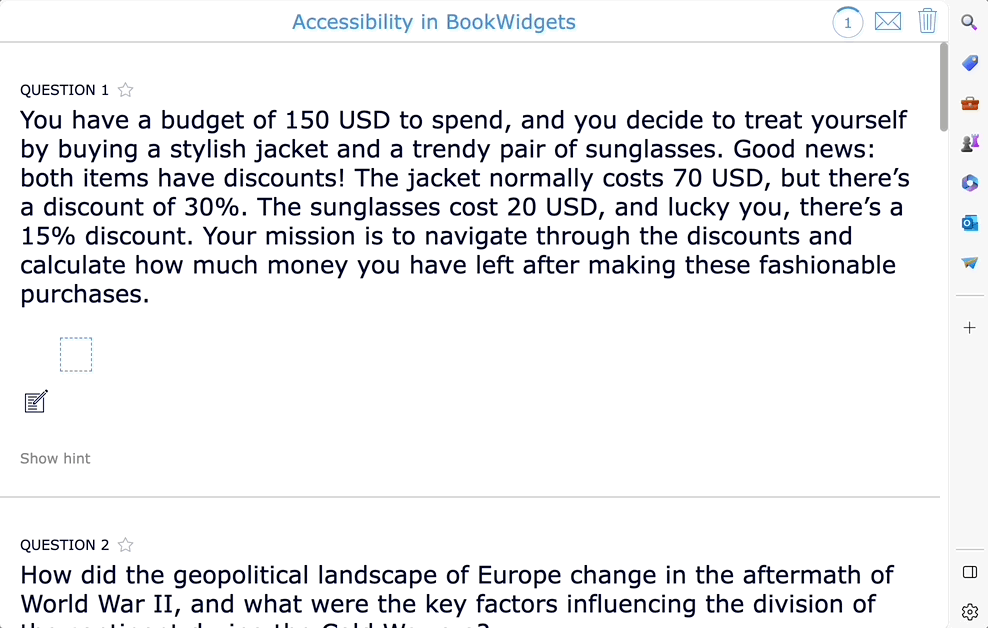
19. Google Translate Chrome Extension
You’ve probably translated text with Google Translate before, but did you know that there is also a Chrome extension for it? This is super handy to support students who don’t master the Language of Instruction (yet): they can select any text on a website (and thus also a BookWidgets exercise) and have it translated automatically. They can also listen to both the original text and the translation.
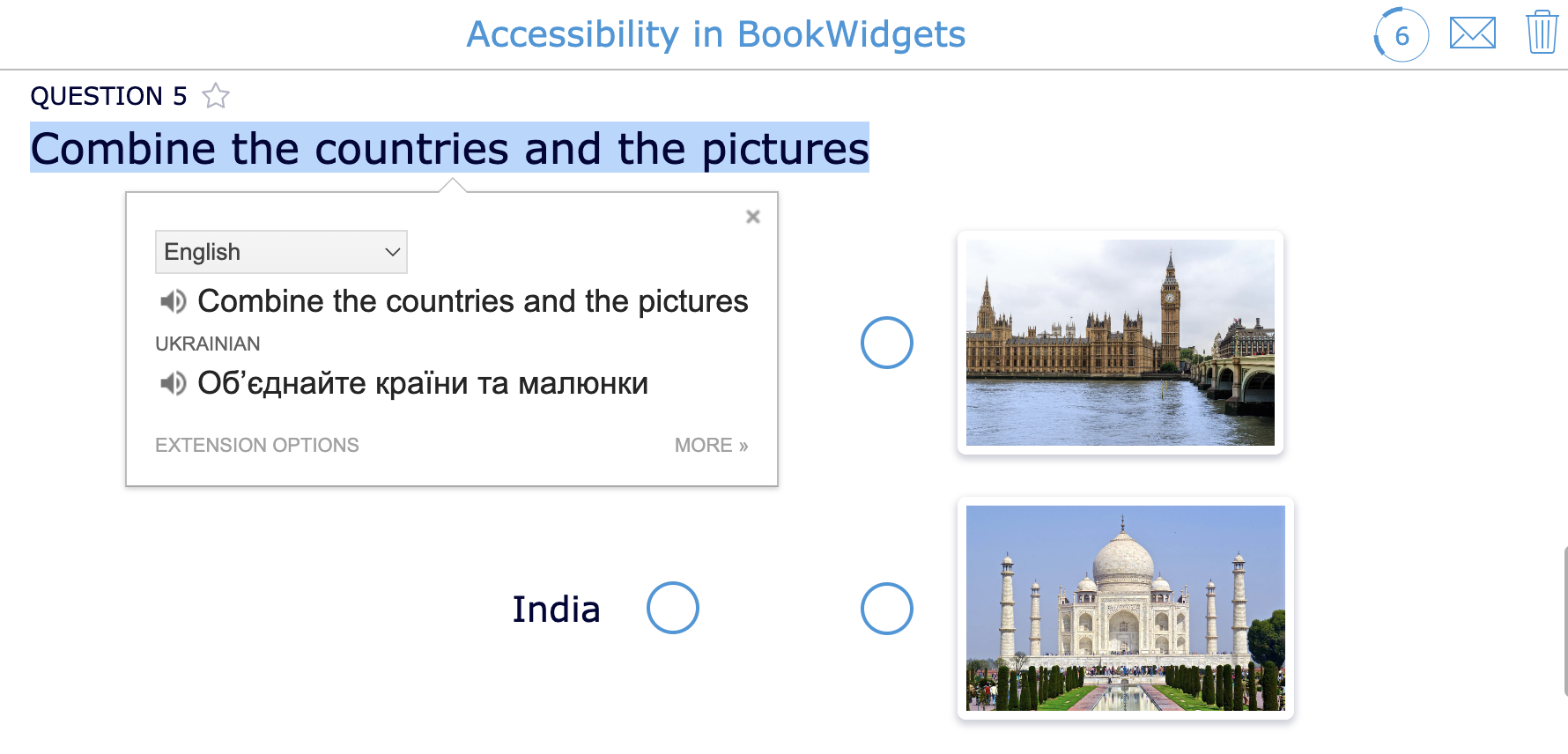
20. ChatGPT
In the very first tip, we already explained that students sometimes need help understanding instructions and, as a result, are not able to complete a task, even though they have the necessary knowledge and skills. AI tools such as ChatGPT can help. What is important is that they master an additional skill: prompting. With a good prompt, AI can help learners formulate an instruction more simply and clearly.
Below is a conversation we had with ChatGPT starting with the following prompt:
I’m a 6th grader and got the following assignment for math. As I’m not a native English speaker, I’m struggling to understand the instructions. I don’t understand the word “discount”. Could you rephrase these instructions, making them as easy to understand as possible, with easy words and bullets. “You have a budget of 150 USD to spend, and you decide to treat yourself by buying a stylish jacket and a trendy pair of sunglasses. Good news: both items have discounts! The jacket normally costs 70 USD, but there’s a discount of 30%. The sunglasses cost 20 USD, and lucky you, there’s a 15% discount. Your mission is to navigate through the discounts and calculate how much money you have left after making these fashionable purchases.”

21. AltAI Chrome Extension
In recent months, much has been said and written about the drawbacks and dangers of artificial intelligence (AI). Still, it is clear that these technologies also offer many opportunities. In the previous tip, we showed how ChatGPT can help students with trouble understanding instructions. For visually impaired students, there are AI tools that can describe the content of an image, which can be very helpful. AltText.ai is one such tool, which also has a handy Chrome extension.
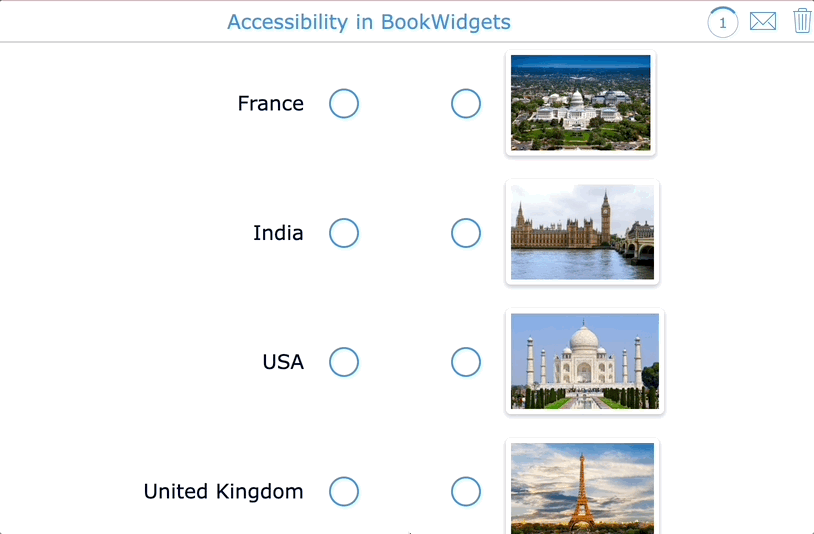
Wrap up
So, that’s a lot! I hope I was able to inspire you in this blog post about how to make interactive exercises as accessible as possible without a lot of extra effort. Moreover, many of the tips will make your lesson content more accessible to all students, not just the students with learning difficulties or disabilities.
Do you have any other tips? Share them with us on Facebook or X, or directly with me on Linkedin.
Do you have ideas on how BookWidgets can improve in terms of accessibility? Be sure to send it to support@bookwidgets.com


